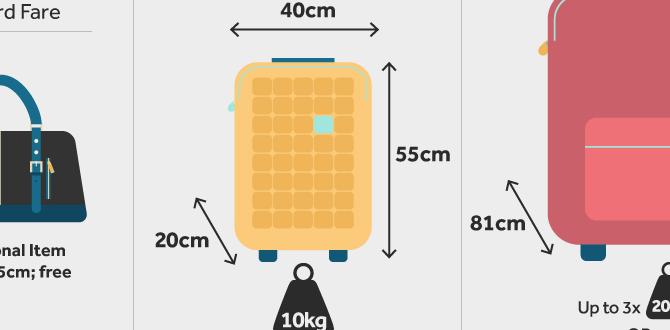Planning an Alexandria shoulder season trip is incredibly smart! You’ll enjoy fewer crowds, pleasant weather, and better deals, making your visit to this historic U.S. city incredibly comfortable and memorable. This guide will walk you through everything you need to know to make your trip seamless.
Welcome to Journey Essentials! Planning a trip, especially to a city steeped in history like Alexandria, Virginia, can feel like a big task. You might wonder about the best time to visit, what to pack, or how to make the most of your experience without the peak season rush. We’ve all been there, staring at travel guides and feeling a little overwhelmed. But don’t worry!
Alexandria shines during its shoulder seasons – those delightful periods in spring and fall. This guide is designed to be your stress-free companion, breaking down exactly how to plan a fantastic Alexandria shoulder season trip. We’ll cover everything from choosing the right dates to packing smart and making the most of your time on the ground. Get ready for an adventure filled with charm, history, and ease!
Why Choose Alexandria’s Shoulder Season?
Alexandria, Virginia, is undeniably charming. With its cobblestone streets, historic architecture, and waterfront views, it’s a destination that draws visitors year-round. However, visiting during the shoulder seasons – typically spring (April to May) and fall (September to October) – offers a unique set of advantages that can significantly enhance your travel experience. These periods strike a perfect balance, providing pleasant weather without the intense crowds and high prices often associated with the summer months or major holidays.
The shoulder seasons allow for a more relaxed and intimate exploration of Alexandria’s rich history and vibrant modern life. Imagine strolling down King Street without jostling for space, enjoying a leisurely meal at a waterfront restaurant, or visiting historical sites with ample time for reflection. This is the essence of a shoulder season trip: access to all the magic of Alexandria, but at a more comfortable pace and often for a more budget-friendly price. We’ll delve into why this is the optimal time and how to plan for it.
Understanding Alexandria’s Shoulder Seasons
Alexandria experiences distinct weather patterns throughout the year, making the shoulder seasons particularly appealing. Understanding these nuances will help you pack appropriately and plan your activities.
Spring in Alexandria (April – May)
Spring is a time of renewal in Alexandria. The weather begins to warm up nicely after the chill of winter, encouraging outdoor activities.
- Temperature: Average temperatures range from the low 50s (°F) in early spring to the comfortable mid-70s (°F) by late May.
- Precipitation: While generally pleasant, spring can bring occasional rain showers. It’s wise to be prepared for a mix of sunshine and rain.
- Bloom: Trees and flowers begin to bloom, adding a beautiful natural palette to the historic city.
- Crowds: Crowds start to pick up as the weather improves, but they are generally more manageable than in the summer. Major holidays like Easter can see a slight spike in visitors.
Fall in Alexandria (September – October)
Autumn is often considered one of the most beautiful times to visit Alexandria. The oppressive summer heat subsides, and the city is bathed in a golden light.
- Temperature: Expect average temperatures to be in the 60s and 70s (°F) in September, gradually cooling down to the 50s and 60s (°F) by late October.
- Precipitation: Fall is typically drier than spring, with crisp, clear days being common. However, occasional autumn storms can occur.
- Foliage: The changing leaves offer stunning scenery, especially along the waterfront and in the city’s many parks.
- Crowds: Similar to spring, fall sees fewer crowds than summer. It’s a popular time for school groups or special events, but overall, it remains less congested.
Essential Planning Steps for Your Alexandria Shoulder Season Trip
To ensure your Alexandria shoulder season trip is as smooth and enjoyable as possible, a little planning goes a long way. Here’s a step-by-step guide to help you organize your adventure.
Step 1: Choose Your Dates Wisely
While both spring and fall are excellent, consider your preferences. Do you prefer the budding freshness of spring or the crisp beauty of autumn? Look at a calendar and avoid major holidays if your priority is minimal crowds. For example, visiting in mid-April to mid-May or mid-September to mid-October often provides the sweet spot of good weather and fewer people. Check local event calendars for Alexandria and Washington D.C. (as it’s a short ride away) to ensure no major festivals or events might coincide with your visit if you’re looking for the quietest experience.
Step 2: Accommodation Tactics
Shoulder season travel often means better accommodation deals. However, Alexandria is a popular destination, so booking in advance is still recommended, especially if you have specific needs or preferences.
- Booking Platforms: Utilize sites like Booking.com, Expedia, or Airbnb. Compare prices and read reviews carefully.
- Location: Decide if you want to stay directly in Old Town Alexandria for easy walkability or in a nearby neighborhood for potentially lower prices and easier parking. Staying near the King Street-Old Town Metro station offers great access to transit.
- Types of Stays: Options range from boutique hotels in historic buildings to modern amenities and even vacation rentals.
- Flexibility: If your dates are flexible, you might snag last-minute deals, but for shoulder season, it’s generally safer to book a few months out.
Step 3: Transportation Planning
Getting to and around Alexandria is relatively straightforward. Consider your arrival and departure methods and how you plan to navigate the city.
- Getting There:
- Air Travel: Ronald Reagan Washington National Airport (DCA) is the closest, offering easy access via the Metro. Washington Dulles International Airport (IAD) and Baltimore/Washington International Thurgood Marshall Airport (BWI) are further but often have more flight options.
- Train: Amtrak service to Alexandria (ALX) is frequent and convenient, especially if coming from the Northeast Corridor.
- Driving: Alexandria is accessible via major highways, but parking in Old Town can be challenging and expensive.
- Getting Around Alexandria:
- On Foot: Old Town Alexandria is very walkable, with most attractions within easy reach.
- DASH Bus: This local bus service provides an affordable and efficient way to get around Alexandria, including a free King Street Trolley route.
- Metro: The King Street-Old Town station on the Blue and Yellow lines connects Alexandria to Washington D.C. and other surrounding areas.
- Ride-Sharing: Uber and Lyft are readily available.
- Biking: Capital Bikeshare stations are available throughout the city, offering another great way to explore.
Step 4: Attractions and Activities – Shoulder Season Perks
Alexandria boasts a wealth of historical sites, charming shops, and fantastic dining. Shoulder season allows you to experience these with less hustle.
Must-See Attractions:
- Historic Homes: Gadsby’s Tavern Museum, Carlyle House Historic Site, and the Rectory offer glimpses into colonial life.
- Waterfront: Enjoy the scenic views, stroll along the boardwalk, or take a boat tour.
- Shopping: Explore the boutiques and galleries along King Street.
- National Port of Entry: Visit the Alexandria Black History Museum.
- George Washington’s Mount Vernon: A short drive or ferry ride away, this iconic estate is a cornerstone of American history. Shoulder season makes visiting Mount Vernon far more pleasant.
Shoulder Season Activity Ideas:
- Outdoor Dining: Enjoy patios and outdoor seating at restaurants without the intense heat or frigid cold.
- Historic Walking Tours: Take advantage of pleasant weather for guided or self-guided tours of Old Town.
- Waterfront Cruises: Enjoy scenic views from the Potomac River with comfortable temperatures.
- Museum Visits: Explore the many smaller museums and galleries at your own pace.
Step 5: Packing Essentials for Comfort and Preparedness
Packing for shoulder season requires versatility. The key is to layer and be prepared for a range of temperatures and potential rain. For travelers managing personal care needs, like adult or child diapers, ensuring comfort and discretion is paramount.
Clothing Considerations:
- Layering is Key: Pack light sweaters, long-sleeved shirts, and t-shirts. You can add or remove layers as needed throughout the day.
- Outerwear: A medium-weight jacket or a waterproof/windproof shell is essential. A light scarf can add warmth and style.
- Bottoms: Comfortable trousers, jeans, or chinos are suitable. Consider a skirt or dress for warmer days if you prefer.
- Comfortable Walking Shoes: You’ll be doing a lot of walking on cobblestones, so supportive and comfortable shoes are a must.
- Socks: Pack plenty of pairs, especially if wearing closed-toe shoes.
Personal Comfort and Care:
For travelers who require personal absorbent products, like adult diapers or child diapers, comfort, reliability, and discretion are no less important during travel. Shoulder season’s variable weather can sometimes impact skin sensitivity, making the right product choice crucial.
- High-Quality Diapers: Look for brands known for their absorbency and skin-friendliness. Products designed for overnight use often offer superior protection for long travel days or unpredictable weather. For children, choosing breathable options can prevent irritation.
- Discreet Carrying: Use a toiletry bag or a separate compartment in your luggage to keep products organized and private. This allows for easy access without drawing attention.
- Change Considerations: Pack a few extra changes of clothes and additional absorbent products in your day bag. Wet wipes and disposal bags are also incredibly useful for changes on the go.
- Comfortable Underwear: For those using protective underwear, ensuring a good fit and breathable material is vital.
- Skin Protection: Consider bringing a barrier cream to help prevent skin irritation, especially if you anticipate longer periods between changes.
Other Essentials:
- Umbrella or Rain Poncho: A compact umbrella or a lightweight rain jacket is indispensable for spring showers or unexpected autumn drizzle.
- Reusable Water Bottle: Stay hydrated and reduce waste.
- Portable Charger: Keep your phone or other devices powered up for navigation and photos.
- Camera: Capture the historic beauty!
- Small Backpack or Day Bag: Perfect for carrying essentials while exploring.
Step 6: Dining and Entertainment
Alexandria’s culinary scene is thriving, with options for every palate and budget. Shoulder season dining is a pleasure.
- Reservations: For popular restaurants, especially on weekends, making reservations is advisable, even in the shoulder season.
- Explore King Street: The main thoroughfare offers a wide array of dining options, from casual cafes to upscale bistros.
- Waterfront Dining: Enjoy seafood and other cuisines with charming river views.
- Farmers Markets: Depending on the time of year, you might catch a local farmers market for fresh produce and artisanal goods.
- Live Music and Theatre: Check local listings for performances at venues like the historic Ford’s Theatre (in D.C., easily accessible) or smaller local establishments.
Step 7: Budgeting for Your Trip
While shoulder season offers savings, it’s still important to budget effectively. Here’s a breakdown of common expenses:
| Category | Estimated Cost Range (per person, per day) | Notes |
|---|---|---|
| Accommodation | $120 – $250+ | Varies greatly by hotel type and location. Shoulder season can offer discounts. |
| Food | $50 – $100+ | Includes a mix of casual and moderate dining. |
| Activities & Attractions | $20 – $50 | Entry fees for museums, historic sites, tours. |
| Local Transportation | $5 – $20 | Metro rides, DASH bus, shared ride services. |
| Miscellaneous | $20 – $50+ | Souvenirs, unexpected purchases, tips. |
Tips for Saving:
- Look for hotel packages that include breakfast or parking.
- Take advantage of D.C.’s many free museums if you plan a day trip.
- Enjoy picnics with items from local markets.
- Utilize public transport and walking as much as possible.
Navigating Alexandria with Ease: A Day Trip Example
To illustrate how a shoulder season trip can unfold, here’s a sample itinerary focusing on the core of historic Alexandria.
Sample Itinerary: A Perfect Fall Day in Old Town Alexandria
Morning (9:00 AM – 12:00 PM):
- Arrive via Metro to King Street-Old Town Station.
- Begin with a stroll down King Street, enjoying the architecture and browsing shop windows before they get too busy.
- Visit Gadsby’s Tavern Museum to step back into the 18th century.
- Continue to the waterfront, enjoying the crisp autumn air.
Lunch (12:00 PM – 1:30 PM):
- Choose a charming café or restaurant along King Street or on a side street for a relaxed lunch.
Afternoon (1:30 PM – 5:00 PM):
- Explore the Carlyle House Historic Site for more colonial history.
- Wander through some of the picturesque side streets, taking photos of the historic homes.
- Visit the Alexandria Black History Museum for a deeper understanding of the city’s diverse past.
- Perhaps enjoy a coffee or treat at a local bakery.
Late Afternoon/Evening (5:00 PM onwards):
- Freshen up if you’re staying locally, or prepare for dinner.
- Enjoy dinner at a restaurant of your choice, perhaps one with a patio if the weather is still pleasant.
- Consider a leisurely walk along the waterfront as the sun sets.
- Head back to the Metro or your accommodation.
This itinerary is flexible and highlights how you can comfortably experience key sites without feeling rushed, a true benefit of shoulder season travel.
Maximizing Your Comfort and Reducing Travel Stress
Beyond the logistical planning, focusing on your personal comfort can transform your trip. This is especially true for travelers who may need discreet personal care items.
Comfort as Priority
When you prioritize comfort, your entire travel experience shifts. This means:
- Packing Appropriately: As discussed, layers, comfortable shoes, and items for varying weather are key.
- Staying Hydrated: Easy to forget, but vital for energy and overall well-being. Carry a reusable water bottle.
- Taking Breaks: Don’t try to cram too much into one day. Schedule in downtime to rest and recharge.
- Mindful Eating: Enjoy local cuisine, but also opt for lighter meals when needed to maintain energy levels.
Stress-Free Personal Care on the Go
For adults and children who rely on absorbent products, planning ahead is essential for a nearly seamless experience. The goal isn’t just convenience, but dignity and uninterrupted enjoyment of your travels.
- Pre-Trip Preparation: Ensure you have an adequate supply of your preferred adult diapers or child diapers. Consider purchasing discreet travel packs or combining supplies into more manageable, less conspicuous portions.
- Easy Access: Keep a small, discreet pack of essentials (e.g., a couple of adult diapers, wipes, disposal bags) in your day bag. This ensures immediate availability without needing to access your main luggage.
- Privacy: When changing in public restrooms, use the largest stall available. Some airports and larger facilities offer family restrooms which can provide more space and privacy. If you are traveling with children who use diapers, a “family” or “companion care” restroom can be a godsend, offering ample space for a changing table and a parent.
- Disposal: Always be prepared to dispose of used items properly. Small, sealable plastic bags are excellent for containing any odor and keeping items contained until you find a trash receptacle.
- Comfortable Fit: Ensure the products you bring are the correct size and offer a secure, comfortable fit. This is crucial for preventing leaks and skin irritation, especially during long journeys or in varying temperatures.






